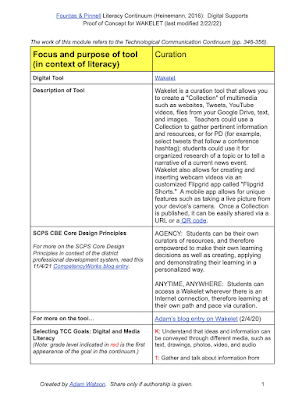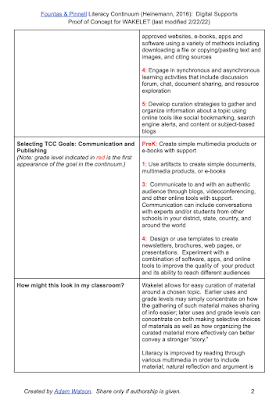If you are an educator who is wrestling with improving preK-8 student literacy, you likely are already very familiar with Irene C. Fountas and Gay Su Pinnell. As their Twitter profile summarizes, they are "authors of books, videos, & websites that are considered standards in the fields of literacy and professional development." Besides a very helpful website full of resources, they have also created a preK-8 Literacy Continuum published in a popular book, most recently given an expanded edition in 2016.
As a former high school English teacher with limited foundational elementary reading and writing instructional expertise, I have to admit that I did not have a deep knowledge of Fountas and Pinnell until Jill Brookman, our district Literacy Coach, met with me to discuss their Literacy Continuum book -- in particular, an intriguing part of the book that details their "Technological Communication Continuum." (The entire book and its extensive Literacy Continuum has proven very effective in helping Ms. Brookman coach our teachers in improving their instructional pedagogy.) As the authors explain, the literacy of learners today is much more expansive than just engaging in printed text. Students must also demonstrate their computer literacy (the use of various devices to "create documents, find information, and communicate with others"), online reading and information literacy (comprehending, as well as critically evaluating, such text), and composing and publishing digital texts (which in a multimedia world is much more complex than simply typing a story in a word processing program!) (pp. 346-347). With such digital communication in mind, Fountas and Pinnell put their preK-8 Technological Communication in a continuum as a progressive set of standards, or in their parlance, "goals" to select. These student "behaviors and understandings to notice, teach and support" are organized into two categories for each grade level: Digital and Media Literacy (reading, or the consuming of electronic text) and Communication and Publishing (writing, or the creation of electronic text) (pp. 348-356).
Ms. Brookman knows I am constantly looking for ways to more authentically connect learning objectives to technology integration. (A recent example: how I crosswalked edtech with competency-based design principles, as featured in Eliot Levine's July 2021 CompetencyWorks blog entry.) So she posed a challenge. Using the Technological Communication Continuum standards, could I describe how a specific edtech tool could exemplify high rigor literacy? Would these standards help me articulate how you can integrate edtech with greater intentionality in a teacher's lessons plans to invoke deeper student learning?
Challenge accepted! As a proof of concept, I used Wakelet (a wonderful tool I previously discussed here) as my prototype modules; Wakelet is a natural fit for curating resources (reading) as well as storytelling (writing). These two modules were organized around a template I created with several sections, such as:
- Description of Tool. Explaining briefly what the edtech tool is, and how it works.
- SCPS CBE Core Design Principles. How does the tool align with our district's competency-based education beliefs what is best for learners, such as supporting student "Agency" or "Anytime, Anywhere" learning? (These Principles were adapted from Aurora Institute's updated 2019 definition of CBE, explained here.)
- Selecting TCC [Technological Communication Continuum] Goals: Digital and Media Literacy. What reading or media consumption Continuum goals does the tool best achieve? The grade level where the goal is first stated in the continuum is highlighted.
- Selecting TCC [Technological Communication Continuum] Goals: Communication and Publishing. What writing or media creation Continuum goals does the tool best achieve? Again, the grade level where the goal is first stated in the continuum is highlighted.
- How might this look in my classroom? Further detailed explanations and concrete examples of how the intentional usage of the edtech tool helps further literacy.
Both modules for Wakelet are together and viewable in the PDF linked here. You can also see screenshots of the first three pages of the document below, with the focus on using Wakelet for curation:
Besides Wakelet, there are certainly other worthy edtech tools that can go hand in hand with exemplifying these Fountas and Pinnell Technological Communication Continuum literacy standards. I encourage others to use the template above to do so, and articulate their own deeper, richer synthesis of intentional edtech with more effective literacy instruction. And I thank Jill Brookman for introducing me to the highly illuminating Literacy Continuum book!



No comments:
Post a Comment